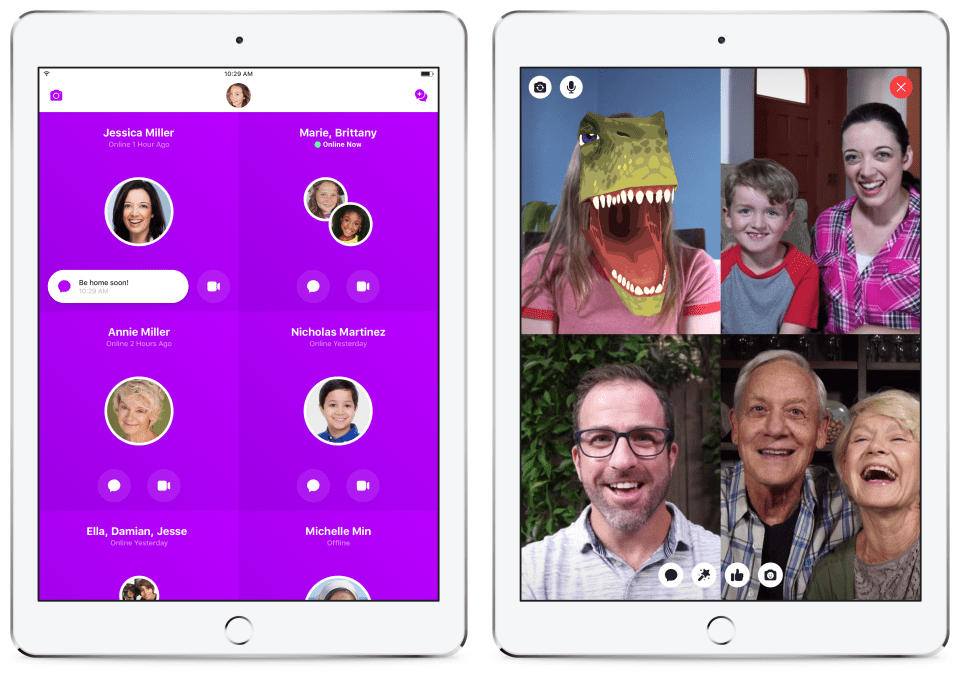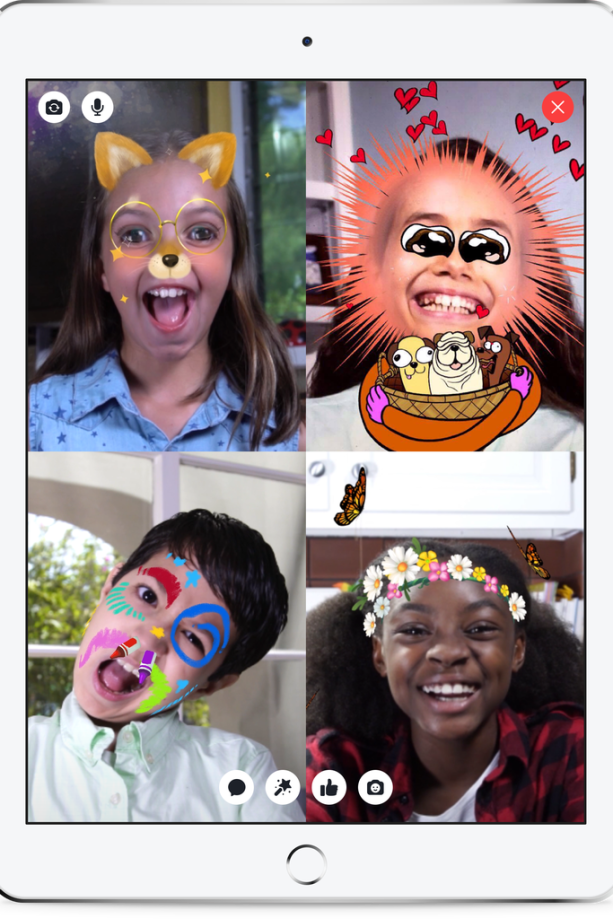Update on January 10, 2018: Messenger Kids is also available for Fire tablets.
Update on February 14, 2018: Messenger Kids is also available on the Google Play Store.
Original post published December 4, 2017:
Today, in the US, we’re rolling out a preview of Messenger Kids, a new app that makes it easier for kids to safely video chat and message with family and friends when they can’t be together in person. After talking to thousands of parents, associations like National PTA, and parenting experts in the US, we found that there’s a need for a messaging app that lets kids connect with people they love but also has the level of control parents want.
To give kids and parents a fun, safer solution, we built Messenger Kids, a standalone app that lives on kids’ tablets or smartphones but can be controlled from a parent’s Facebook account. Whether it’s using video chat to talk to grandparents, staying in touch with cousins who live far away, or sending mom a decorated photo while she’s working late to say hi, Messenger Kids opens up a new world of online communication to families. This preview is available on the App Store for iPad, iPod touch and iPhone. (Update: As of January 10, 2017, Messenger Kids will also available be available for Fire tablets and as of February 14 it will be available on the Google Play Store).
Co-Developed With Parents, Kids and Experts
Today, parents are increasingly allowing their children to use tablets and smartphones, but often have questions and concerns about how their kids use them and which apps are appropriate. So when we heard about the need for better apps directly from parents during research and conversations with parents, we knew we needed to develop it alongside the people who were going to use it, as well as experts who could help guide our thinking.
In addition to our research with thousands of parents, we’ve engaged with over a dozen expert advisors in the areas of child development, online safety and children’s media and technology who’ve helped inform our approach to building our first app for kids. We’ve also had thought-provoking conversations around topics of responsible online communication, parental controls and much more with organizations like National PTA and Blue Star Families, where we heard firsthand how parents and caregivers approach raising children in today’s digitally connected world.
And for the past several months, many families at Messenger and Facebook have used the app and helped come up with some of the key features like the easy-to-use parental controls.
More Fun For Kids, More Control For Parents
Messenger Kids is full of features for kids to connect with the people they love. Once their account is set up by a parent, kids can start a one-on-one or group video chat with parent-approved contacts. The home screen shows them at a glance who they are approved to talk to, and when those contacts are online.

Playful masks, emojis and sound effects bring conversations to life.

In addition to video chat, kids can send photos, videos or text messages to their parent-approved friends and adult relatives, who will receive the messages via their regular Messenger app.
A library of kid-appropriate and specially chosen GIFs, frames, stickers, masks and drawing tools lets them decorate content and express their personalities.

Messenger Kids gives parents more control. Parents fully control the contact list and kids can’t connect with contacts that their parent does not approve. Parents control kids accounts and contacts through the Messenger Kids Controls panel in their main Facebook app:

How to Get Started
Every child account on Messenger Kids must be set up by a parent. For parents, setting your child up with a Messenger Kids account is done in four steps:
- Download: First, download the Messenger Kids app on your child’s iPad, iPod touch, or iPhone from the App Store. Update: As of January 20, you can also download the app from the Amazon Appstore.
- Authenticate: Then, authenticate your child’s device using your own Facebook username and password. This will not create a Facebook account for your child or give them access to your Facebook account.
- Create an account: Finish the setup process by creating an account for your child, where all you’ll need to do is provide their name. Then the device can be handed over to the child so they can start chatting with the family and friends you approve.
- Add contacts: To add people to your child’s approved contact list, go to the Messenger Kids parental controls panel in your main Facebook app. To get there, click on “More” on the bottom right corner in your main Facebook app, and click “Messenger Kids” in the Explore section.
More Information and What’s Next
There are no ads in Messenger Kids and your child’s information isn’t used for ads. It is free to download and there are no in-app purchases. Messenger Kids is also designed to be compliant with the Children’s Online Privacy and Protection Act (COPPA).
This preview of Messenger Kids is only available in the US at this time on the Apple App Store, and will be coming to Amazon App Store and Google Play Store in the coming months.
We’ve worked extensively with parents and families to shape Messenger Kids and we’re looking forward to learning and listening as more children and families start to use the iOS preview.
To learn more about Facebook’s approach to building technologies for kids and the questions we’ve asked ourselves and discussed with others along the way, read our Hard Questions blog post.
For more specific information about the app, visit messengerkids.com.
For the latest on how to use Messenger Kids, visit our Help Center.
National PTA does not endorse any commercial entity, product, or service. No endorsement is implied.
